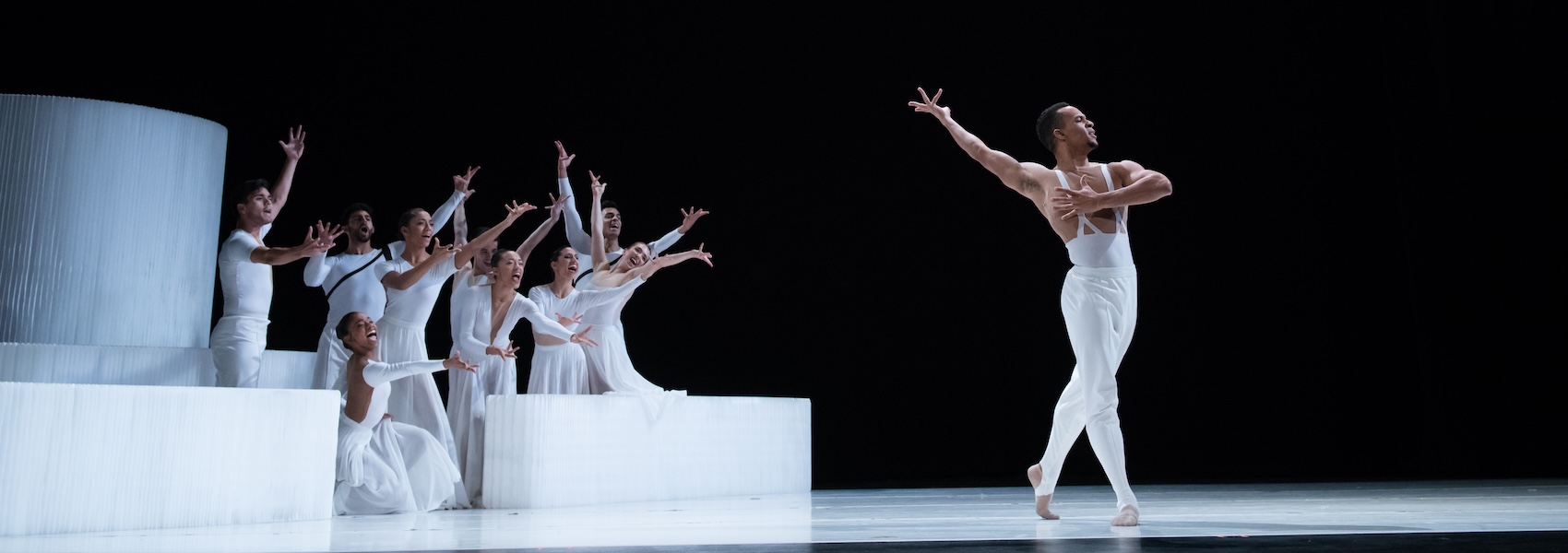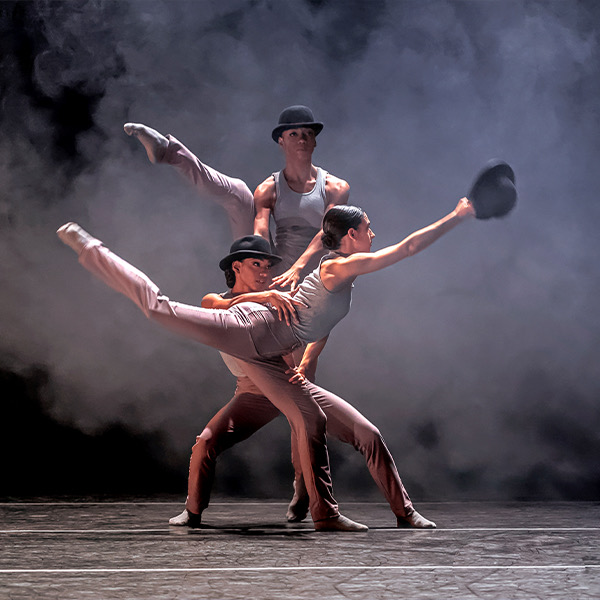Ballet Hispánico
- Thursday, October 2, 7:30 p.m.
- Frederick C. Tillis Performance Hall
Take your students on an unforgettable journey to celebrating the rich cultural heritage and dynamic spirit of Hispanic dance with Ballet Hispánico. Ballet Hispánico's performances are engaging, educational, and culturally enriching and feature excerpts from Ballet Hispánico's repertoire, live dance sessions, and Q&A opportunities with teaching artists and educators.
What Will My Students Experience?
This program is fifty minutes long and features a variety of dance styles including Afro-Caribbean dance, flamenco, salsa, jazz, hip-hop, ballet, contemporary dance, and traditional Latin dance.
These performances, known as Performances for Young People, take audiences on a guided journey through Latin dance and culture. They feature excerpts from Ballet Hispánico's repertoire, narrated by the company's artistic leadership to provide context and insights into the choreography and cultural significance.
The performance includes interactive elements such as live dance sessions and Q&A opportunities with the teaching artists and educators. This immersive experience helps students connect with the art of dance and the rich cultural heritage it represents.
What Will My Students Learn?
In addition to learning about the important role dance plays in Hispanic culture, students will also learn about Hispanic icons like Celia Cruz and Tito Puente.
How Can I Connect This to What I Am Teaching?
Regardless of grade level you are teaching, there are many ways to connect a performance by Ballet Hispánico to what your students are currently learning.
-
Help world language students understand how dance tells stories that reflect the history, myths, and legends of a culture.
-
Encourage history and social studies students to explore the cultural and historical significance of Latin dance, including its origins, evolution, and role in social movements. This can also help students understand the broader context of Latin American cultures.
-
Guide language arts students through reading and writing exercises that reflect upon how dance allows individuals to express their emotions, values, and beliefs. Or have students analyze the cultural impact of a specific Latin dance style (such as salsa, tango, or merengue) globally and on its country of origin.
-
Introduce physical education students to Latin dance styles like salsa, merengue, and bachata to promote physical fitness, coordination, and rhythm.
-
Prepare music education students to study the musical elements of Latin dance such as rhythm, melody, and instrumentation. Students can also learn about different Latin music genres and how they influence dance styles.
-
Inspire art education students to create visual art projects inspired by Latin dance. Possible art projects include such as designing costumes, posters, or stage sets to help students appreciate the visual aspects of dance performances.
Please scroll down to the section titled “Educational Standards Alignment” for a list of relevant standards selected from state and national frameworks.
What Should I Know?
The Origins of Ballet Hispánico
Ballet Hispánico, founded in 1970 by Puerto Rican-Mexican-American dancer and choreographer Tina Ramirez, is a renowned dance company based in Manhattan, New York. The organization was established to celebrate and promote Hispanic culture through dance, reflecting the diverse experiences of Hispanic and Latino Americans.
Over the years, Ballet Hispánico has grown into the nation's largest Hispanic cultural organization, offering world-class performances, educational programs, and community arts partnerships. Under the leadership of Artistic Director Eduardo Vilaro since 2009, the company continues to honor its rich legacy while expanding its artistic reach.
Ballet Hispánico's significance lies in its dedication to preserving and showcasing Hispanic cultural heritage, fostering a deeper understanding and appreciation of Latin dance and traditions.
Who Was Celia Cruz and How Did She Influence Latin Dance?
Celia Cruz, born Úrsula Hilaria Celia Caridad Cruz Alfonso on October 21, 1925, in Havana, Cuba, was a legendary Cuban American singer known as the "Queen of Salsa." Her powerful voice and vibrant performances made her a global icon in Latin music.
Cruz's career began in Cuba, where she performed with the popular orchestra La Sonora Matancera. After moving to the United States in 1961, she became a central figure in the salsa music scene, recording numerous albums and collaborating with other renowned artists. Celia Cruz brought salsa music to the forefront of Latin culture. Her energetic and rhythmic songs inspired countless dancers and helped popularize salsa dance worldwide.
Cruz's performances were not only musically captivating but also visually stunning, with her flamboyant costumes and dynamic stage presence. Her contributions to salsa music and dance have left an enduring legacy, making her a beloved figure in the world of Latin dance and culture.
Who Was Tito Puente and How Did He Influence Latin Dance?
Tito Puente, often referred to as "El Rey" (The King), was a legendary figure in Latin music, known for his mastery of the timbales and vibraphone. Born in New York City in 1923 to Puerto Rican parents, Puente's music blended Afro-Cuban rhythms with jazz, creating a vibrant and innovative sound.
His energetic performances and compositions, such as "Oye Como Va" and "Ran Kan Kan," became anthems in mambo and salsa dancing. Puente's contributions to Latin dance are profound, as his music not only set the rhythm for dancers but also brought Latin dance into the mainstream, fostering cultural exchange and appreciation. His legacy continues to inspire dancers and musicians around the world.
Did You Know? Celia Cruz performed at the UMass Fine Arts Center on April 25, 1999, and that Tito Puente performed here on April 24, 1998?
A Closer Look
Dance holds a special place in Latin American and Hispanic culture where it serves as a vibrant expression of identity, history, and community. From salsa and tango to flamenco and merengue, each dance style reflects the region's unique cultural heritage and traditions.
Dance is often used to celebrate important events, tell stories, and convey emotions, making it an integral part of social gatherings and festivals. The rhythmic movements and passionate performances connect people across generations, preserving cultural values and fostering a sense of unity.
Additionally, Latin dance has influenced global music and fashion, showcasing the richness and diversity of Hispanic culture to audiences worldwide.
Watch the video below for an overview of the evolution of Latin Dance. How many dances do you already know?
Think About It
Consider any iteration of the following questions to help deepen your students’ understanding of the Ballet Hispánico performance.
-
What role does dance play in your own cultural or family traditions?
-
What were the most memorable moments of the performance for you, and why?
-
How do you think dance helps in expressing cultural identity and heritage?
-
Have you learned any dances from other cultures? If so, how did that experience impact your understanding of those cultures?
-
In what ways do you think dance can bring people together and foster a sense of community?
-
How does dance influence your personal identity and self expression?
-
What new insights did you gain about Hispanic culture through the performance?
-
In what ways can dance be used as a tool for social change and community building?
Educational Standards Alignment
While the following list is not a complete list of applicable standards, it provides a set of relevant standards you can use to develop lessons in line with state and national standards and requirements.
Massachusetts 2018 Curriculum Framework for History and Social Science
United States History II Content Standards
Topic 5. United States and globalization [USII.T5]
5. Analyze some of the major technological and social trends and issues of the late 20th and early 21st centuries (e.g., the computer and technological revolution beginning in the 1980s, scientific and medical discoveries such as DNA research, major immigration and demographic changes such as the rise in Asian and Hispanic immigration).
National Core Arts Standards
Dance / Connecting
DA:Cn10.1 Anchor Standard: 10. Synthesize and relate knowledge and personal experience to make art.
Enduring Understanding: As dance is experienced, all personal experiences, knowledge, and contexts are integrated and synthesized to interpret meaning.
Essential Question: How does dance deepen our understanding of ourselves, other knowledge, and events around us?
Dance / Connecting
DA:Cn11.1 Anchor Standard: 11. Relate artistic ideas and works with societal, cultural and historical context to deepen understanding.
Enduring Understanding: Dance literacy includes deep knowledge and perspectives about societal, cultural, historical, and community contexts.
Essential Question: How does knowing about societal, cultural, historical and community experiences expand dance literacy?
CASEL Competencies (Social and Emotional Learning)
Social Awareness (Recognizing strengths in others)
The ability to understand the perspectives of and empathize with others, including those from diverse backgrounds, cultures, and contexts. This includes the capacities to feel compassion for others; understand broader historical and social norms for behavior in different settings; and recognize family, school, and community resources and supports.






